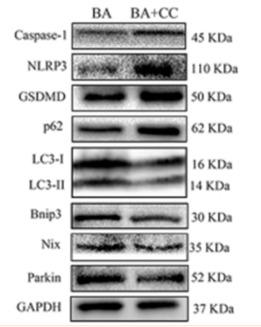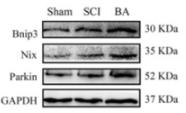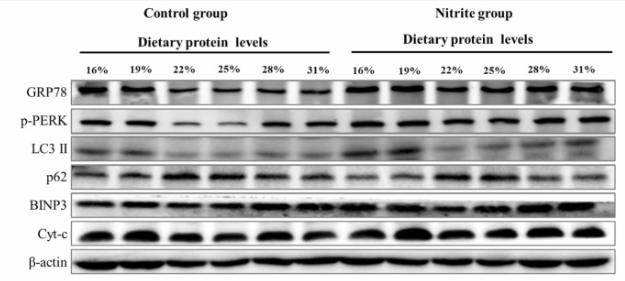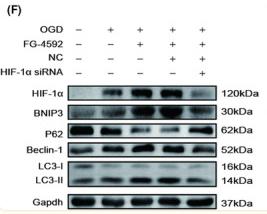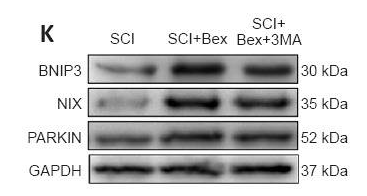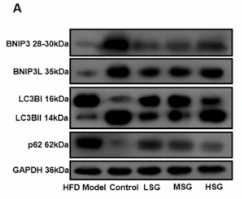BNIP3 Antibody - #DF8188
| Product: | BNIP3 Antibody |
| Catalog: | DF8188 |
| Description: | Rabbit polyclonal antibody to BNIP3 |
| Application: | WB |
| Cited expt.: | WB |
| Reactivity: | Human, Mouse, Rat |
| Prediction: | Pig, Bovine, Horse, Sheep, Rabbit, Dog, Chicken, Xenopus |
| Mol.Wt.: | 30 kDa; 22kD(Calculated). |
| Uniprot: | Q12983 |
| RRID: | AB_2841498 |
Related Downloads
Protocols
Product Info
*The optimal dilutions should be determined by the end user. For optimal experimental results, antibody reuse is not recommended.
*Tips:
WB: For western blot detection of denatured protein samples. IHC: For immunohistochemical detection of paraffin sections (IHC-p) or frozen sections (IHC-f) of tissue samples. IF/ICC: For immunofluorescence detection of cell samples. ELISA(peptide): For ELISA detection of antigenic peptide.
Cite Format: Affinity Biosciences Cat# DF8188, RRID:AB_2841498.
Fold/Unfold
BCL2 Adenovirus E1B 19kDa Interacting Protein 3; BCL2/adenovirus E1B 19 kDa protein interacting protein 3; BCL2/adenovirus E1B 19 kDa protein-interacting protein 3; BNIP 3; BNIP3; BNIP3_HUMAN; NIP 3; NIP3;
Immunogens
A synthesized peptide derived from human BNIP3, corresponding to a region within C-terminal amino acids.
- Q12983 BNIP3_HUMAN:
- Protein BLAST With
- NCBI/
- ExPASy/
- Uniprot
MSQNGAPGMQEESLQGSWVELHFSNNGNGGSVPASVSIYNGDMEKILLDAQHESGRSSSKSSHCDSPPRSQTPQDTNRASETDTHSIGEKNSSQSEEDDIERRKEVESILKKNSDWIWDWSSRPENIPPKEFLFKHPKRTATLSMRNTSVMKKGGIFSAEFLKVFLPSLLLSHLLAIGLGIYIGRRLTTSTSTF
Predictions
Score>80(red) has high confidence and is suggested to be used for WB detection. *The prediction model is mainly based on the alignment of immunogen sequences, the results are for reference only, not as the basis of quality assurance.
High(score>80) Medium(80>score>50) Low(score<50) No confidence
Research Backgrounds
Apoptosis-inducing protein that can overcome BCL2 suppression. May play a role in repartitioning calcium between the two major intracellular calcium stores in association with BCL2. Involved in mitochondrial quality control via its interaction with SPATA18/MIEAP: in response to mitochondrial damage, participates in mitochondrial protein catabolic process (also named MALM) leading to the degradation of damaged proteins inside mitochondria. The physical interaction of SPATA18/MIEAP, BNIP3 and BNIP3L/NIX at the mitochondrial outer membrane regulates the opening of a pore in the mitochondrial double membrane in order to mediate the translocation of lysosomal proteins from the cytoplasm to the mitochondrial matrix. Plays an important role in the calprotectin (S100A8/A9)-induced cell death pathway.
Mitochondrion. Mitochondrion outer membrane>Single-pass membrane protein.
Note: Coexpression with the EIB 19-kDa protein results in a shift in NIP3 localization pattern to the nuclear envelope. Colocalizes with ACAA2 in the mitochondria. Colocalizes with SPATA18 at the mitochondrion outer membrane.
Belongs to the NIP3 family.
Research Fields
· Cellular Processes > Transport and catabolism > Autophagy - animal. (View pathway)
· Environmental Information Processing > Signal transduction > FoxO signaling pathway. (View pathway)
· Human Diseases > Infectious diseases: Bacterial > Legionellosis.
References
Application: WB Species: Mice Sample: spinal cords
Application: WB Species: Mice Sample: spinal cords
Application: WB Species: Mouse Sample:
Application: WB Species: Fish Sample: gill tissue
Application: WB Species: Mouse Sample: spinal cord
Application: WB Species: Mouse Sample:
Application: WB Species: Rat Sample: BMSCs
Restrictive clause
Affinity Biosciences tests all products strictly. Citations are provided as a resource for additional applications that have not been validated by Affinity Biosciences. Please choose the appropriate format for each application and consult Materials and Methods sections for additional details about the use of any product in these publications.
For Research Use Only.
Not for use in diagnostic or therapeutic procedures. Not for resale. Not for distribution without written consent. Affinity Biosciences will not be held responsible for patent infringement or other violations that may occur with the use of our products. Affinity Biosciences, Affinity Biosciences Logo and all other trademarks are the property of Affinity Biosciences LTD.

